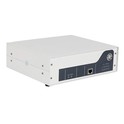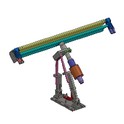Hey there! As a supplier of ultrasonic filtration systems, I've been diving deep into the ins and outs of how these systems work. One question that often comes up is, "How does the particle concentration affect the filtration efficiency in an ultrasonic filtration system?" Let's break it down and find out.
First off, let's quickly go over what an ultrasonic filtration system is. Essentially, it's a nifty piece of tech that uses ultrasonic waves to enhance the filtration process. There are different types, like the Ultrasonic Pipe Filter and the Ultrasonic Tank Filter. These systems are great for a bunch of industries, from manufacturing to wastewater treatment.
Now, onto particle concentration. Particle concentration refers to the amount of particles present in a given volume of fluid. It can vary widely depending on the source of the fluid. For example, industrial wastewater might have a much higher particle concentration compared to tap water.
So, how does this concentration impact filtration efficiency? Well, when the particle concentration is low, the filtration process is generally smoother. There are fewer particles to clog up the filter, so the fluid can pass through more easily. The ultrasonic waves in the system can effectively dislodge any particles that do stick to the filter, keeping it clean and maintaining a good flow rate.
Let's say you're using an Ultrasonic Pipe Filter in a system where the particle concentration is relatively low. The ultrasonic waves create tiny bubbles that implode near the filter surface. This implosion, known as cavitation, helps to shake off any particles that might be starting to build up. Since there aren't too many particles in the first place, the filter can do its job efficiently, and you'll get a high - quality filtrate.
On the other hand, when the particle concentration is high, things get a bit more challenging. With a large number of particles in the fluid, the filter gets clogged up much faster. The ultrasonic waves still try to do their thing, but they might struggle to keep up. As the filter clogs, the flow rate of the fluid decreases. This means that the system has to work harder to push the fluid through the filter, which can lead to increased energy consumption.


For instance, if you're using an Ultrasonic Tank Filter in a situation where the fluid has a high particle concentration, you might notice that the filtration time increases. The filter pores get filled up quickly, and the ultrasonic waves might not be able to clean them fast enough. This can result in a lower filtration efficiency, as some particles might slip through the filter or the overall amount of filtrate produced in a given time is reduced.
Another aspect to consider is the size of the particles. Even at a high particle concentration, if the particles are very small, they might not clog the filter as quickly as larger particles. However, small particles can be more difficult to capture in the first place. The ultrasonic waves can help by causing the small particles to agglomerate, or stick together, into larger clumps. This makes it easier for the filter to trap them.
But if the particle concentration is extremely high and the particles are of various sizes, the system can really struggle. The larger particles can cause immediate blockages, while the smaller particles can get lodged in the filter pores, making it even harder for the ultrasonic waves to clean the filter.
To deal with high particle concentrations, there are a few strategies. One option is to pre - filter the fluid before it enters the ultrasonic filtration system. This can remove the larger particles, reducing the load on the main filter. Another approach is to adjust the intensity of the ultrasonic waves. By increasing the power of the ultrasonic generator, you can enhance the cavitation effect and potentially clean the filter more effectively.
It's also important to regularly monitor the particle concentration in the fluid. This can help you anticipate any issues with filtration efficiency and take appropriate action. For example, if you notice that the particle concentration is starting to increase, you might decide to increase the frequency of filter cleaning or adjust the operating parameters of the system.
In conclusion, particle concentration plays a crucial role in the filtration efficiency of an ultrasonic filtration system. Low particle concentrations generally lead to better performance, while high concentrations can pose challenges. But with the right strategies and proper monitoring, you can still achieve good filtration results even in high - concentration situations.
If you're in the market for an ultrasonic filtration system and want to learn more about how it can handle different particle concentrations, or if you have any other questions, I'd love to have a chat. Whether you're dealing with low or high particle concentrations, our systems are designed to provide efficient and reliable filtration. Let's start a conversation about how we can meet your specific filtration needs.
References
- "Ultrasonic Filtration Technology: Principles and Applications" - A technical report on the basic concepts of ultrasonic filtration.
- "Particle Filtration in Industrial Processes" - A research paper that discusses the impact of particle concentration on filtration in various industries.






